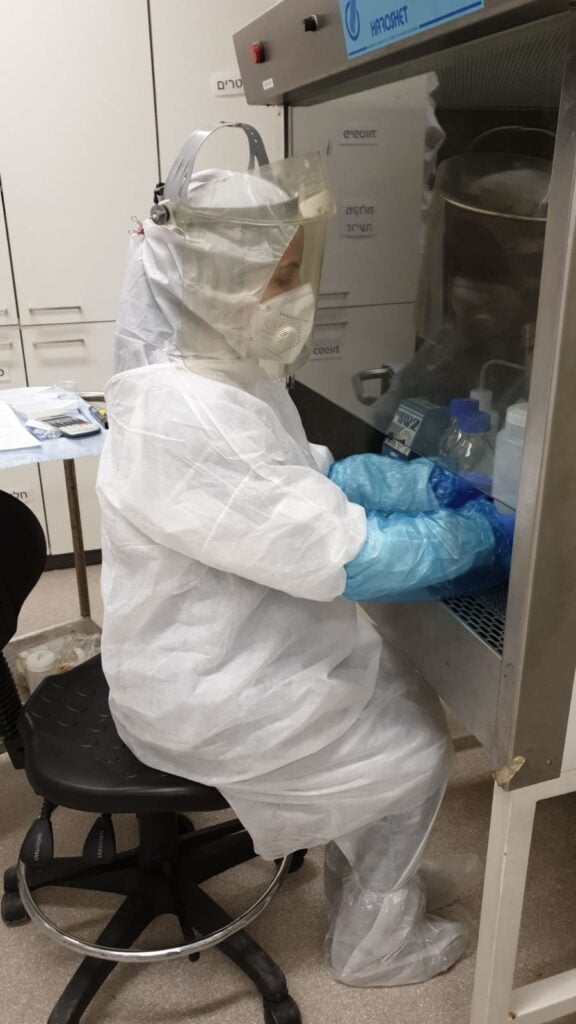Israeli researchers studying wastewater warn that a new COVID-19 wave could hit this summer and also suggest that while the Omicron variant is on its way out, their research shows the Delta variant is “biding its time” and could make a resurgence in the next few months.
The highly contagious Delta variant was first identified in India in late 2020. Omicron, which later replaced Delta as a predominant variant, was considerably milder. While Delta wiped out the variants that came before it, Omicron did not eliminate Delta, according to BGU researchers Prof. Ariel Kushmaro and Dr. Karin Yaniv, who were part of the team behind the published scientific paper.

The findings, which were published in the peer-reviewed journal Science of The Total Environment, are based on the methodology developed by scientists from the Ben-Gurion University of the Negev to trace the SARS-CoV-2 virus that leads to COVID-19 through sewage and wastewater systems.
Prof. Kushmaro says that while they cautiously predict a possible new COVID-19 wave as well as the reemergence of the Delta variant, the team doesn’t know what it means just yet.

“The assumption is that there are still variants that are circulating in the community and they can be the next wave. So my take-home message is that we still need to take precautions — to use a mask in crowded indoor areas and not fully close the checks in the airport and other means that can contain the epidemic,” he tells NoCamels.
Wastewater continues to give indications of where the coronavirus is active, even when the PCR testing and rapid testing of people decline, Prof. Kushmaro explains.
“The data [that we have] is for all of the city of Beersheba. So it’s like a pooled sample of more than 200,000 people in one sample. You can see a change in viral load according to a change in morbidity in the population. You can do it in small cities, you can do it in neighborhoods, and you don’t need people to test specifically.. Especially today, people don’t go to tests themselves. So the only window for what’s going on in the population is via wastewater detection,” Prof. Kushmaro explains.
The researchers of this study tested sewage from December 2021 to January 2022. First, Prof. Kushmaro’s lab team developed sensitive arrays that can differentiate variants from each other in wastewater.
The process is very similar to the test that the Ministry of Health is doing to test for the coronavirus on human beings, Prof. Kushmaro says. After scientists collect sewage samples for 24 hours, they extract the RNA of the virus and amplify specific primers related to its gene.
Sign up for our free weekly newsletter
Subscribe“It means we can identify different parts of the spikes or the envelope of the virus and we can be specific. So we will not just have a yes or no, we will be able to quantify in numbers,” he adds.
After collecting samples for a year and building a model around it with the help of Prof. Rodney Granek of the Department of Biotechnology Engineering, the team noticed a “disturbing interaction between the Omicron and Delta variants,” according to the university’s statement.
“As you see in the picture, the upper panel, all the gray, is total coronavirus. So if you’re looking at the numbers from November 2021, you see that the coronavirus is fairly stable. And then it goes up, as Omicron is going up. The black line is the mobility of people who tested positive for the coronavirus, according to the Ministry of Health. The blue bars are specifically the Delta variant. We see that the Delta here is stable in the numbers — but we see that there is no indication from the Ministry of Health. According to this kind of positive in the sewage, it means that there is a ‘cryptic circulation’ of the Delta variant in the community.”

According to the model, the Delta variant is expected to continue to circulate undetected, in what the team calls “cryptic circulaton,” until it causes a wave. Meanwhile, the Omicron variant – in orange – will increase and then decrease until it goes away, while the Delta variant will remain in circulation.
Before the peak of the Omicron variant, this model showed that Omicron would peak in February of this year “and this is exactly what happened,” he adds. Then the model showed the decrease of the Omicron variant in May “and here we are in May and it has almost disappeared,” Prof. Kushmaro adds.
“So in 10 days from now, it will probably be almost nothing. But if Delta continues to circulate in low numbers — when Omicron goes away and immunity goes down, then the spread of the variant will go up again.”
“Resulting wastewater data illustrated the very initial Delta-Omicron dynamics occurring in real time. Despite this, the future development and dynamics of the two variants side-by-side is still mainly unknown. Based on the initial results, a double susceptible-infected-recovered model was developed for the Delta and Omicron variants,” the researches wrote in the study, “According to the developed model, it can be expected that the Omicron levels will decrease until eliminated, while Delta variant will maintain its cryptic circulation. If this comes to pass, the mentioned cryptic circulation may result in the reemergence of a Delta morbidity wave or in the possible generation of a new threatening variant. In conclusion, the deployment of wastewater-based epidemiology is recommended as a convenient and representative tool for pandemic containment.”
Related posts

Israeli Medical Technologies That Could Change The World

Harnessing Our Own Bodies For Side Effect-Free Weight Loss

Missing Protein Could Unlock Treatment For Aggressive Lung Cancer




Facebook comments